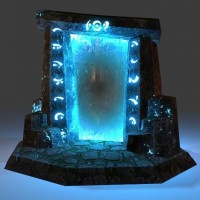Top Ten Ways In Which Sci-fi Movies Are Scientifically Inaccurate
I like sci-fi, but there are inaccuracies in abundance with most sci-fi stories. Observe.Time travel is nowhere near as easy as sci-fi makes it seem. To travel at a different rate in time relative to any reference frame, one has to use the effects of relativity to dilate time. This will require extreme acceleration or extreme gravitational influence. However, sci-fi tends to make loops through the spacetime continuum, which repeats events already observed relative to another reference frame, however, to achieve such geometry will require a specifically shaped gravitational field. The only place where this has been mathematically calculated is at the singularity of a rotating black hole, where the laws of physics themselves collapse.
We all know that the speed of light can only be reached in absence of mass and never exceeded, but there's more than that. Even if one could simply travel faster than light, the faster-than-light effect does not happen as you see it in films. The light approaching you will rapidly blueshift until the CMB becomes visible light and blinds you. But before this happens, your field of view expands as the light from behind you meets you. But of course, the curvature of spacetime allows one in a spacelike path to travel back in time.
There is no oxygen in space to provide mega-firey explosions like you get in movies. Sure, explosions happen in space, like supernovae, but nothing burns. The Death Star, for instance, would look like a firecracker. And of course, no sound, as there is no medium for sound to travel through.
We often see things just fall directly into a black hole as if it were a vacuum cleaner. No. Black holes slow down time at such a rate that your approach slows when observed from outside. And because light from beneath the event horizon cannot escape, one would never see anything cross it. We would only see the light from the object redshift before disappearing completely. And in sci-fi, data has been attempted to have been recovered after entering a black hole. This cannot happen from what we know. Firstly, objects become violently torn down to their fundamental particles by the tidal forces before becoming frozen in spacetime at the singularity. But secondly, the entropy of the system breaks down in ways unknown to science due to the negative heat capacity of a black hole. It's impossible to undo the damage done simply by entering a black hole.
We establish that high speeds are used in sci-fi. The objects in the spaceship, however, have less momentum at the same velocity, so if the spaceship loses this momentum quickly, the people inside are subject to greater acceleration. It would be harder to simply stay in your seat like Picard ordered.
We see lasers because light from the lasers is scattered by particles in the path of the laser. In space, there is nothing to scatter the light, so you'd only see a laser in space if it were pointed or reflected directly at you. Also, you get no sound from them, as there is no sound in space.
You can't call the Klingons from 50 lightyears away in an instant, simply because the radio signals used will take 50 years. One would need a quantum entanglement system. And they can't get there in less than that time unless they use the curvature of spacetime specifically, such as with a wormhole.
Maybe they are not Lightsabers, but actually Plasmasabers where the plasma is trapped to specific lengths by using magnetic bottles.
The simple question is this: How do you get light to freeze in space a metre from its source?
Where does it come from? We currently know of four fundamental forces. The strong and weak nuclear forces have too small a range, the electromagnetic force requires the objects involved to be charged or magnetised, and so cannot be used on all objects, and both EM and gravity act towards a point, which would influence everything around it from all angles.
Asteroids aren't so dangerous as they appear. In reality, they don't cluster impossibly close together without making a heavier object, nor does their spin affect their trajectory as if it were on a surface.
They can't use flaps because no air or something like it in space, the ships don't have any kind of special kind of propulsion for turning?
